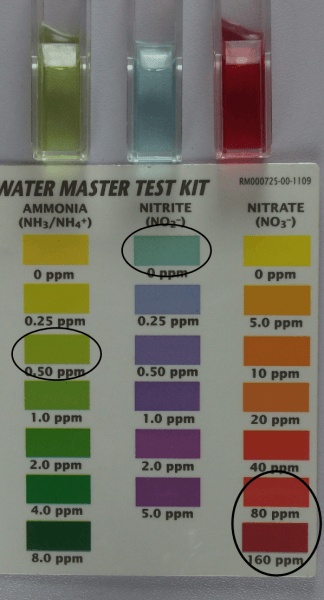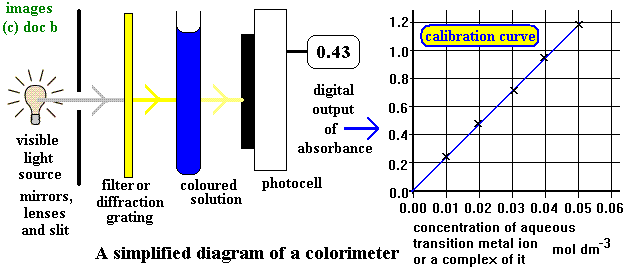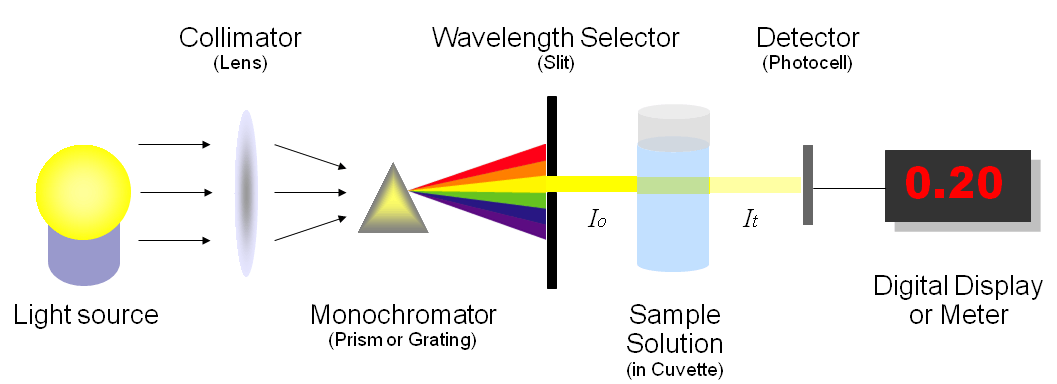Water Quality Photometers and Colorimeters Information
Water quality photometers and colorimeters are instruments designed to determine the concentration of a solution from its color density.
Colorimetric Analysis
Colorimetry is a widely-used, effective method for testing water quality. This process involves adding a chemical reagent to a water sample to be measured. Because the color absorption is proportionally dependent upon the chemical substances found within the sample, the concentration of certain chemicals can be determined by comparing the colored sample to a reference color.

Reference swatches representing various concentrations of ammonia, nitrite, and nitrate.
Image credit: IO Rodeo
The proportional nature of absorption and light transmission discussed above is described by Beer-Lambert's law, which is actually an amalgamation of two separate laws. Beer's law purports that the amount of monochromatic light passing through a colored solution decreases exponentially as a result of an increase in concentration of the colored substance:
7144fff059814689932b751b85be9e33.gif)
where:
It = intensity of transmitted light
Io = intensity of incident light
e = base of the natural logarithm
K = a constant
C = concentration
According to Lambert's law, the amount of transmitted light decreases exponentially with an increase in colored solution thickness:
48272bf22acb4d4ab38c5614c82cb59e.gif)
where all variables are identical to the above equation and T represents the solution's thickness. Therefore, by combining Beer's law—which deals with absorbance proportional to the sample's concentration—and Lambert's law, which deals with absorbance proportional to the sample's thickness, we can address both thickness and concentration using the Beer-Lambert law:
d3b73380acbb4c84a1b24e61fbf84f55.gif)
where IE is the intensity of emerging light and all other variables are defined as above. Therefore, by knowing the molar absorption coefficient and the unique wavelength of a substance in water, an unknown sample can be compared and the concentration can be determined.
Colorimeters
The image below shows the simplified operation of a typical colorimeter. In this example, light of a substance-specific wavelength is passed through a solution containing the substance. (This wavelength is one known to be strongly absorbed by the substance.) The transmitted light strikes a photocell which measures the amount of light absorbed and outputs this figure as absorbance. By comparing the figure to a reference curve, an operator can determine the concentration of the substance within the solution.

The colorimetry process. Image credit: Doc Brown's Chemistry
Photometers
Photometers are electronic devices which function as digital colorimeters. By eliminating the subjective element (namely the human eye) and variable light conditions associated with visual colorimeters, photometers are capable of providing much more accurate measurements.
All photometers consist of five basic elements:
- A white light source
- Some form of wavelength control
- A sample compartment
- A detector
- A meter
An operating photometer moves through these components sequentially. The light source emits white light, which is then filtered using the wavelength control. The resultant wavelengths pass through the sample and are sensed by the detector, which in conjunction with the meter displays either the percent transmittance or percent absorbance.
While all photometers perform the function listed above, they can be classified into two different product groups depending upon the method of controlling emitted light:
- Electrophotometers use a simple optical filter to obtain specific wavelengths. These filters are specifically tailored to the constituent to be measured; therefore changing the intended constituent requires changing to a separate filter. Electrophotometers are typically used to measure single constituents, commonly residual chlorine and nitrates.
- Spectrophotometers use a prism or diffraction grating to filter wavelengths. By changing the angle of the prism, the transmitted wavelength can be altered accordingly. This attribute makes spectrophotometers much more versatile than electrophotometers, as they are capable of measuring several different constituents using the same prism or filter.

Basic photometer operation.
Image credit: UC Davis
Device Selection Criteria
Colorimeters and photometers are both uniquely suited to different water quality analysis applications. Some factors to consider when selecting a device are listed below.
- Accuracy required: photometers are more accurate than colorimeters, as they eliminate the subjective human aspect of colorimetry.
- User skill: colorimeters generally require experienced staff to compare and match samples to reference colors. Digital photometers require little skill to operate.
- Operation: colorimeters are robust and user-friendly despite being less accurate than photometers.
Water Quality Constituents
Water quality analysis consists of measuring the presence and quantities of certain constituents, or chemical substances, which reside in a sample. The table below lists several common constituents and groups of constituents. Note that some of these—such as heavy metals—are necessary for biological function in small amounts but toxic in larger quantities.
|
Constituent / Group |
Description |
Examples |
|
Ammonia |
Carries a pungent smell; often used in fertilizers; mildly toxic to humans and highly toxic to aquatic life. |
|
|
Chlorine |
Widely used as a disinfectant; respiratory system irritant. |
|
|
Heavy metals |
Toxic in high concentrations; typically byproducts of smelting and other operations. |
Iron, manganese, cadmium, zinc. |
|
Nitrates |
Naturally-occurring; used in fertilizers and as oxidizers; toxic in larger amounts. |
|
|
Ozone |
Carries detectable odor; harmful to humans if inhaled or ingested in sufficient quantities. |
|
|
Phosphates |
Byproducts of fertilizer disposal; may cause formation of uranium in drinking water. |
Hydrogen phosphate, dihydrogen phosphate. |
|
Radon |
Airborne respiratory irritant; may be harmful to humans if ingested. |
Standards
Water quality colorimeters and photometers may be produced, tested, and used according to various published standards. A few example standards are listed below.
- CIE 53 - Methods of characterizing the performance of radiometers and photometers
- BS ISO 11352 - Water quality: estimation of measurement uncertainty based on validation and quality control data
References
UC Davis Chemwiki - Spectrophotometry
- Aluminum
- Ammonia
- Analog Meter or Indicator
- Analog current signal
- Analog voltage signal
- Application Software Included
- Auto Wavelength Selection
- Automatic Calibration
- Battery Powered
- Bromine
- Chlorine Dioxide
- Computer Interface
- Copper
- Cyanide
- Cyanuric Acid
- DEHA/Oxygen Scavengers
- Data Storage or Data Logging
- Digital Front Panel
- Digital Readouts
- Fixtured or Permanent
- Fluoride
- Free Chlorine
- Handheld
- Hardness (Magnesium or Calcium)
- Hexavalent Chromium
- Hydrazine
- Hydrogen Peroxide
- Iodine
- Iron
- Manganese
- Molybdate
- Nickel
- Nitrate
- Nitrite
- Ozone
- Parallel Interface
- Peracetic Acid
- Phenols
- Phosphate
- Phosphorus
- Portable
- Self-Test Diagnostics
- Serial Interface
- Silica
- Sulfide
- Switch or alarm signal
- Temperature Compensation
- Total Chlorine
- Total Petroleum Hydrocarbons
- Video Display Terminal
- Water or Weather Resistant Housing
- Zinc
- photoelectric colorimeter
- colorimeter
- ammonia sensor
- Ammonia meter
- Hydrogen Peroxide meter
- silica analyzer
- tristimulus colorimeter
- Free Chlorine meter
- hydrocarbon detector
- Hydrocarbons Sensor
- Iron Sensor
- Phosphate Sensor
- Aluminum Sensor
- Ammonia Handheld Detector
- Free Chlorine
- Glycol Sensor
- Hexavalent Chromium Sensor
- minolta colorimeter
- Nitrite Sensor
- Ozone Sensor
- Bromine meter
- chlorine controller
- chlorine dioxide analyzer
- Chlorine Dioxide Sensor
- Colorimeter Distributor
- Cyanuric Acid Sensor
- Free Chlorine in water
- Glycol meter
- Hardness Sensor
- Hydrazine Sensor
